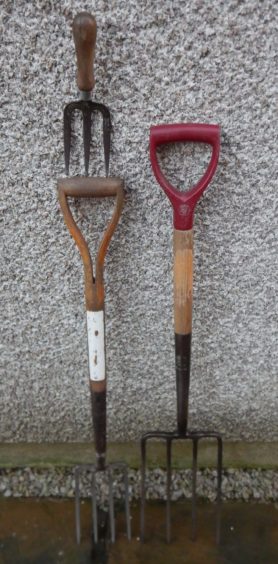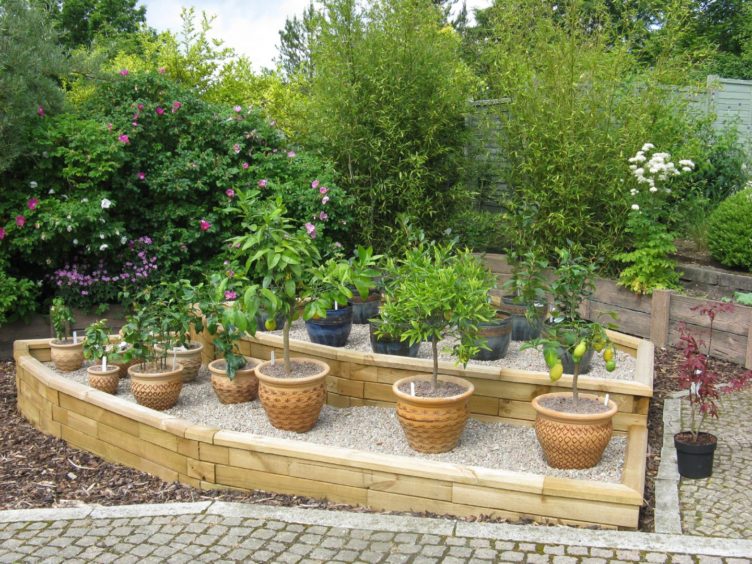Thankfully, at the time of writing, we’ve had some rain – not much, but glad to see it.
Why didn’t it wait for just one more day?
Gardeners are never pleased, but getting towards the end of the working day (for me that would be about 3pm) I finished applying fertiliser to the area where I will plant my early tatties shortly. Should I just crack on and apply the lawn fertiliser now? It won’t take long.
No, I’m going for my cuppa, tomorrow morning will be time enough.
Of course sod’s law came into play then. I wakened next morning to the patter of tiny… raindrops. Fortunately the weather is forecast to be changeable so I will be able to feed the lawn ere long. Having been scarified a couple of weeks ago, the application of a spring feed is now due.
Two days on, no more rain, nonetheless the fertiliser is now spread and if necessary I could get the sprinkler out.
Why am I slightly bothered? It has been dry now for two or three days with a slight frost overnight, the fertiliser is on and going nowhere but it should have been watered in by now.
Instead, will the frost burn the exhausted turf by acting on the fertiliser? Time alone will tell. Irritatingly, I am not following my own advice but I’ll keep you posted on the outcome.
This is also the time to apply a spring feed to the borders, especially around young trees, roses, other shrubs, fruit bushes and hedges.
Q: As you cultivate to kill weeds and slacken up soil beaten down over the winter, what kind of implement would you use for this job?
My suggestion would be something with prongs.
A bladed implement like a Dutch hoe might simply slide over the surface with little penetration – not a lot of use other than to slacken seedling weeds.
I would use a long-handled border fork or a tined cultivator to break up that consolidated surface layer, without disturbing plant roots.
There is quite a range of suitable fertilisers to choose from with specialist brands galore claiming to be the best for this plant or that. Don’t be fooled by the advertising blurb, plants need a gee-up in the spring and for the most part, any general balanced fertiliser will be fine.
I prefer to use an organic- based product, though it may not be the cheapest. Presently I am using a bonemeal-based product.
It is a balanced fertiliser containing a range of plant nutrients.
The additional benefit of using an organic-based fertiliser relates to it being classed as slow-release product, the ingredients being made available to the plants over several weeks.
Q: What’s to be done about the remnants of the mulching material applied last year?
The practice of mulching is sometimes maligned because the material used for mulching does use up nitrogen from the soil in the process of breaking up/rotting down.
This, supposedly causes plants to be starved of this essential plant food – a very debatable point.
As you continue with the spring cultivation, scraping back what’s left of the old mulching material, sprinkling on slow-release fertiliser as recommended, lightly fork it in to the surface.
Finish the job off by refreshing and spreading the mulch.
Where the existing layer has all but disappeared it should be replenished with fresh mulch aiming to create a layer of 5cm or thereby.
Many of you will have another collection of perennials needing a bit of TLC.
I refer, of course, to your house plants. If they are not due to be potted up into a bigger container, they can be given a new lease of life by gently removing the top 25mm layer of soil and replacing it with fresh new compost.
Others being left undisturbed will benefit from a liquid feed, which from now on can be repeated every fortnight or thereby, having removed any older withered leaves.
Included in this group of course will be cyclamen and indoor azaleas that have finished flowering.
The cyclamen should be kept growing for another month if possible, allowing them to recover from their exertions and to mature the tissues in the corm for next season.
Finally, to answer the annual question from a new gardener – by all means accept the challenge of growing on your poinsettia because it is a perennial shrub, but if you are successful, it could be rather big in six months with little likelihood of producing these wonderful red bracts in time for Christmas 2021.
Professional growers of these plants manipulate the growth with chemicals (which are unlikely to be available to amateur gardeners).
They also “play around” with the balance of night and day. Fascinating stuff, but more importantly extremely difficult to achieve without the facilities.
Just accept that you will have to fork out a tenner for a new plant next December. They are certainly worth it.













